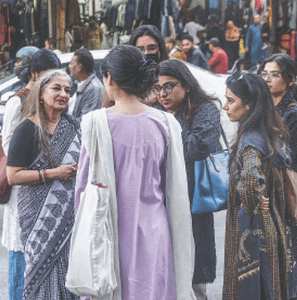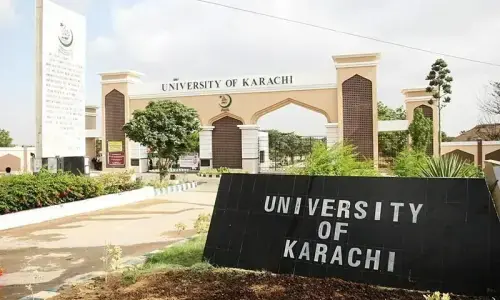KARACHI: The Jewish community was once an integral component of Karachi and played an important role in the city’s development. If its synagogue had not been destroyed, our younger generation could have learnt a lot from their history and the region’s multicultural past.
This was said by scholar Gul Hasan Kalmatti while reading out his insightful paper at the second session of the first two-day International Conference on Karachi at the Arts Council’s auditorium on Saturday.
Mr Kalmatti’s paper was titled Karachi Ke Yahudi. He said as British rule took root in Karachi, quite a few communities (Goan Christians, Parsis and Jews) migrated to the city.
The Jewish community mostly came from Maharashtra. The first place of worship that they built in Karachi was in 1893 near Ranchhor Line (where today a building Madiha Plaza stands). A senior member of the Jewish community, Solomon David, was instrumental in setting up the synagogue called Magan Shalome. He was a respected figure who held important positions, including some in the municipality. The synagogue was the centre of the community’s socio-cultural activities. A couple of years later, two more halls were added to the building. Though some scholars suggested there was one more place of worship for Jews in the city, there were no signs of that, he said.
Mr Kalmatti, the only speaker of the day who spoke in Urdu, said in 1988 the synagogue was burnt and brought down by religious zealots. If it had remained, students of history could have learnt a great deal from it. Solomon David died in 1903 and was buried in the Mewashah graveyard. “When I went to the graveyard to film a documentary, I encountered many difficulties,” said Mr Kalmatti.
He said it was in 1897 that the first Jewish person was buried in the city. Apart from Mewashah, there was another graveyard at Purana Haji Camp. Abraham Robin was another gentleman from the community, who, like Solomon, was a known person. A school named after him was established in 1923 in Khamosh Colony, which to date existed. It existed probably because no one suspected the name ‘Abraham’ as non-Muslim, he added.
Mr Kalmatti said in 1911 a delegation from Aligarh led by Raja Sahib Mehmoodabad came to Karachi. The Jewish community came in droves in the Ramaswamy area and welcomed members of the delegation by showering them with rose petals. There were nine streets between the Ramaswamy and Measham Lea areas, one of which was named after Solomon David. Another noted Karachi Jew was architect Moses Somake who designed such buildings as the Flagstaff House, Jaffer Faddoo Dispensary and Edward House.
In 1901 there were 482 Jews in Karachi. In 1911 they constituted 0.3 per cent of the city’s population and at the time of partition their number had reached 2,500. When in 1948 Israel came into being a lot of Jews migrated to Israel, and after the Arab-Israel war a majority of them left the city. Quite a few of Karachi’s Jews now lived in Ramale, Israel.
At the same session, chaired by Dr Hamida Khuhro, Dr Kaleemullah Lashari gave a presentation on Early History of Karachi, and Dr Michel Boivin’s paper ‘Shaping a new Karachi with the Merchants’ was read out by the host of the programme, Alya Iqbal Naqvi, because Dr Boivin couldn’t make it to the conference.
Dr Framji Minwala and Dr Ali Akbar Husain were the panellists at the session.
The audience was fully engrossed in the presentation, which was why when one of them asked Mr Kalmatti whether the origin of the name Malir lay in the fact that King Lear’s mother (hence Ma Lear) lived there, it created quite a funny situation. Earlier, the moot began with renowned architect and town planner Arif Hasan’s keynote address. He said though a lot had been talked and written about the city, many stories were yet to be told. He said in 1729 Karachi was a strategically located well-protected fortified town. At the time there were 34 temples, 31 mosques and 13 shrines in the city, which meant it was not a small village. In the 1857 mutiny a sobedar from Bareli, Raamdin, was blown up by the British. In 1948 Karachi was separated from Sindh which had its social and cultural repercussions. Then there was nostalgia for the pre-1977 era when there was a culture of night clubs, music and dance.
Mr Hasan argued that violence took place in those cities where there’s peace and diversity, such as Zanzibar, Ahmedabad and Karachi because in those cities the state became party to the conflict. Touching upon Ziaul Haq’s asphyxiating rule, he said the movement against Zia was a movement for the restoration of democracy, whereas it should have been a movement for culture. He said today there was not one but four Karachis: (1) central business district, (2) inner crescent – where Urdu- speaking population lives, (3) outer crescent – low-income groups (4) and the Defence, Clifton areas. A smattering of goths existed around them.
The first session, chaired by Dr Kaleemullah Lashair with Dr Sarfaraz Solangi as the panellist, had two presentations; one by Dr Asma Ibrahim on ‘Prehistoric Karachi’ and the other by Dr Zulfikar Ali Kolhoro on ‘Cup-making in Gadap, Karachi’.
Four presentations were made in the last session of the day chaired by architect Yasmeen Cheema. Arif Hasan and Dr Asif Farrukhi were the panellists. Dr Sohail Agha’s topic was ‘Inequities in Access to Maternal Health Services in Karachi,’ Dr Noman Ahmed spoke on ‘Sensitising students about the built environment,’ Dr Nilofer Halai discussed the private-public divide with reference to teacher education. Sibtain Naqvi’s subject was ‘The onslaught of populism’.
Dr Agha highlighted the issues related to the disparities in, and quality of, maternal health services in Karachi. Dr Ahmed expressed the concern in order to sensitise architecture students vis-à-vis a studio module introduced for bachelor of architecture students at the Dawood College of Engineering and Technology. Dr Halai’s presentation on the private-public divide as far as teacher education went was interesting, but her views on the prevalent cultural myths about the profession were quite intriguing. Among the myths she spoke on was ‘teaching is a noble profession’, ‘content is important than pedagogy,’ and ‘teaching and teacher training is the same thing’.
Sibtain Naqvi’s research on how music, bars and clubs used to be an integral part of yesteryear Karachi’s life elicited a very good response from the audience.
The last item of the day was Sheema Kermani’s special dance recital.


































